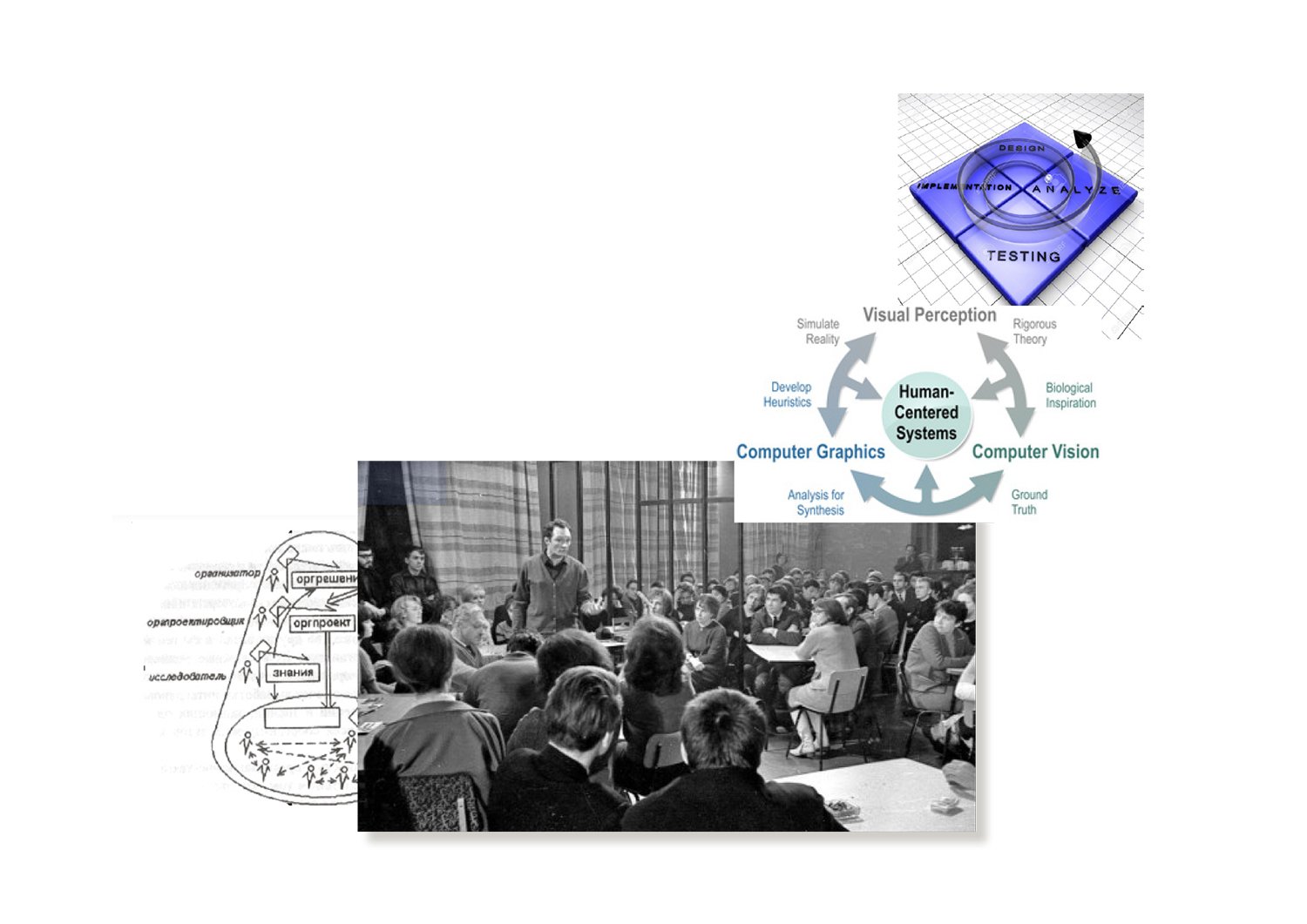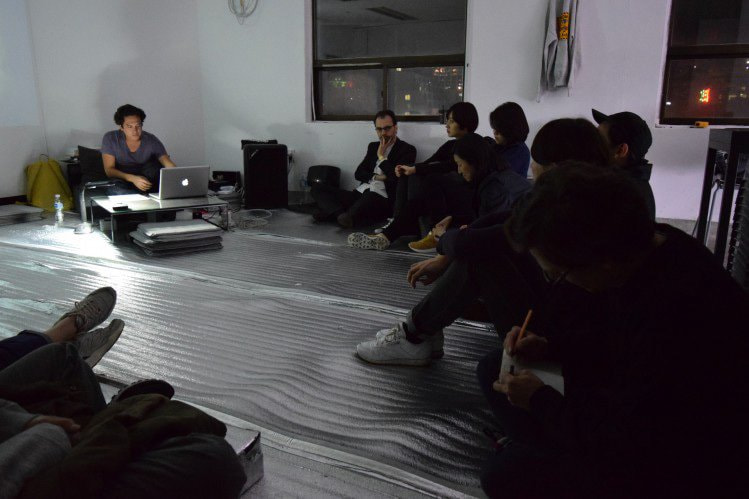Mental cover and survival models
Example of concealment and survival models by Horizon Community. Horizon Community's project is presented as part of Toward the Source.
Environmental conditions
This presentation offers an overview of the survival techniques developed my micro-communities in paradoxical environments. Such principles may be relevant in the contemporary situation, as it is full of contradictions and paradoxes and demands rapid orientation, information management, and the adaptation of social models to new circumstances. The models discussed below have been borrowed from communities that existed at the margins of society—micro-, or subcultures—the name depends on your perspective. Most important here are the specific practices and tools developed by the communities in question. The similarities between them, outlined
in the study, allow us to open up new horizons and create new models of action in an unstable environment of obscure half-truths and changing relations.
The new model is based on the practices of two communities, or circles, that formed under the Soviet regime with its inherent paradox (which later led to a performative shift) that could be summed up as “the total emancipation of the person, who nevertheless remained under the party’s control.”

Essentially, this was a version of the paradox formulated by Claude Lefort, located in the contradiction between the state’s ideological discourse and its actual practices based on that ideology. Such contradictions are normally disguised by appeals to objective truths. The collapse of such “truths” leads to a performative shift, which erodes the state ideology from within. Phantoms of similar processes can be observed in events such as Brexit and the election of Donald Trump in the United States, as well as in many post-digital global changes of the late 2000s and early 2010s.
The term “performative shift” was first used to describe late Soviet socialism by Alexei Yurchak. He analyzed the erosion of Soviet ideology, which prepared the population for the actual collapse of the state. Performative shift means that the performative aspect of ritualized speech acts is separated from, and becomes more important than, their constative aspect.
We will focus on two cases, or two archetypal clusters (communities, circles). One cluster has influenced the development of art institutions and the artistic community as a whole; the other one was influential in political science and the management of production and corporations. In conclusion, a hybrid model will be presented.
The cluster models discussed are thought-activity-based.

Cluster I
Collective Actions, an artist group belonging to the Moscow Conceptualist School (MCS), active from 1976 to 1985.

Main Targets
Goal 1
Develop an extraordinary understanding of ordinary actions or phenomena
Goal 2
Understand the meaningful void through entering the state of no-deception
(Freeing oneself from self-deception)
Goal 3
Generating “the Elsewhere” (the state of being “outside”) in the ideological
discourse



.jpg)
Cluster II
Georgy Shchedrovitsky’s Moscow Methodology Circle (MMС), TAS stage, 1979.
Thought Activity System (TAS) Methodology
– In TAS methodology all “ordinary” words are given unusual
meanings.
– TAS methodology implies very strict thought discipline and
follows extremely rare and unusual thought schemes.
– Along with its huge philosophical and theoretical potential,
TAS methodology has equally important practical and applied
uses.

Main Goals


– As the game has a lot of variables and make-believe, participants perform meaningless actions or actions that might seem meaningless to them. This encourages them to look for ways of changing and perfecting the game; the organization; the means, methods, and techniques of thought-activity.
– Each OAG participant creates knowledge by playing the game. At the same time, the game can be a means of implementing new approaches to organization or communication.
– In OAG, imitation is nothing less than creation of the future.

Through their discussions on the thought process, the circle that formed around the ideas of Georgy Shchedrovitsky, has developed a new communication practice, based on a specific kind of speech act. Quite often, words used in games acquired a new meaning, which creates a situation of being vnye (outside): for example, an imitation of production relations developed into a model of the impossible future of those relations. A good example of a game used in an absurd way is when the organizers set the goal of compiling a detailed list of basic consumer goods for Sverdlovsk Oblast. Such lists are usually determined by the market. Experts in production, trade, design, and distribution were brought together in a health retreat and given several days to decide on the list.
Design for a hybrid cluster
As one can see from the descriptions, there are certain parallels between Cluster I and Cluster II.
A hybrid cluster:
– is a closed community existing at the margins of society. It has its own value system and attaches special meanings to ordinary words, actions, and signs;
– requires leaving the city or creating a situation in a separate space (whether physical or not);
– avoids oppositions and antagonisms, object-subject dichotomy, and focuses on connections, links, and borderline areas between subject and object or object and viewer;
– cannot be properly documented, described, or systematized. Every event is unique even if it is thought through and pre-planned by the organizers;
– places its participants vnye (outside) the current political discourse and ideology by creating a separate micro culture (the Elsewhere). This is not escapism, but penetration of the ecosystem with the aim of transforming it through the infection-like distortion of meaning for a number of it’s agents.
A cluster is a small group of individuals generating the state of being the Elsewhere through collective practices, which nevertheless values individual experiences.
This state can be described as being Here and There (see slide 8). But in general, this is a (science) fiction practice.



In The Time Wanderers (by Boris and Arkady Strugatsky), the protagonist is a progressor who is disappointed in his development mission on other planets and returns to Earth to study the way progressors from advanced civilizations have affected humanity. On Earth, he discovers a human subspecies which, through a number of manipulations, can turn human beings into ludens (meta humans). Although they look just like humans, ludens are aliens among their own kind.
Members of the Moscow Methodology Circle were wrongly accused of acting like Strugatskys’ progressors, who used OAG and other practices to change the social structure, humans themselves, and the world they lived in. Collective Actions might appear to be secret society, performing their rite-like actions (which were indeed meant to transform ordinary events into extraordinary)
on the experimental Kievogorskoe field. Sticking to the Time Wanderers metaphor, one can envisage Collective Actions as ludens trying to activate the new impulse system in humans.

An excerpt from a 2009 conversation between Joseph Backstein and Keti Chukhrov about the Soviet art scene in the late 1980s, when it was “discovered” by the West:
Chukhrov. Yes, but our project was Western as well. Essentially.
Backstein. The Soviet project? That’s only partially true. It claimed to be Western, but whether
it really was is a question. I often say something inappropriate when trying to explain why Europeans have so many illusions regarding Russia. Somehow, they still hope that Russians belong to the same culture, the same civilization. This is because we look European, because we are white. But we are nevertheless a different civilization. We are like aliens. We look the same, but we are different.”
What if the practices described above offer a model of existing in an environment characterized
by inner contradictions at the moment its structural paradoxes begin to manifest themselves
in a clearer way?
Let us forget about the Soviet state, Moscow Conceptualism, and Shchedrovitsky’s circle and think of people who sought refuge from the paradoxes, pressures, and controversial rites of late socialism in an alternative mode of existence, which offered a range of unique opportunities so wide—and allowing one to be here and there at the same time—that it can be useful to us now. In an environment characterized by inherent contradictions (post-truth), where a new technological revolution has made consciousness and the human mind the most important resources and management and understanding of various fields the most important skill, and even non-material areas of human activity are being privatized, such micro-cultural practices may offer a model for survival.


First published in Raznoglasiya magazine (February, 2016).

